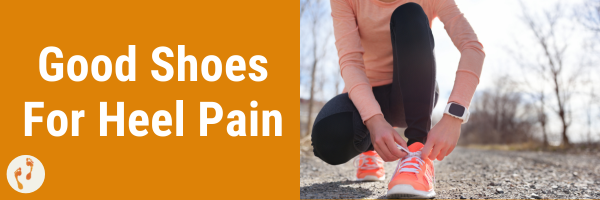Good Shoes For Heel Pain

It’s easy to think that the only thing we need for shoes to be classed as “good” for our feet is that they’re not high heels, aren’t oddly shaped, and are the right length and width. The truth is that there’s a lot more you should be looking for in a good pair of shoes – especially if you have heel pain.
If you’re already experiencing heel pain, it means that your feet are already not coping well with the strain you’re placing them under on a daily basis – and for most, this includes from your footwear. Making wearing good shoes a priority, however, can help reduce the strain on your heels and the tissues attaching to your heels – like the plantar fascia – which is a primary cause of heel pain. Here’s what our podiatrists recommend looking for when choosing shoes when you have heel pain.
A firm heel counter
The heel counter is the part of the shoe immediately behind the heel and often has a stitch or seam in this area. Heel counters should be strong to help control the movement at the heel and ankle, adding stability and helping control the position of the foot. You can tell if a heel counter is strong by trying to push it in with your thumb – the material should stay upright and hold its shape without flexing. This also explains why you shouldn’t ‘slip’ shoes on, as over time it wears down the strength of the heel counter.
Having a strong heel counter best supports those experiencing heel pain by limiting abnormal side-to-side movement, especially where a flat foot type is placing excess strain on the tissues at the bottom of the heel and causing more pain and damage.
Adjustable fastenings (laces/velcro)
The fastenings determine how much control you can have over the fit of your shoe – which is very important in helping the shoes give you optimal stability, support and control. Laces and velcro are preferable as they give the best control. Slip-ons with elastic edges that allow you to pull on the shoe to slide your foot in, give little to no control or support for your ankle (you’ll also notice it’s almost always accompanied by thin and light material), so we recommend avoiding these.
The right width
Alongside checking the length, check the width of your shoe by running your fingers along the sides of the shoe, particularly the outside, looking for any bulging. Having shoes that are too narrow can cause rubbing and pain, foot cramps and may even lead to bunions – as well as exacerbating your heel pain. Shoes that are too wide won’t be well secured to your foot, which leads to excess movement and pressure on the heel, as well as the potential for friction, blisters and other damage.
Ankle support
The height of the shoe around the ankle should sit comfortably below the bony protrusions (malleoli) and help stabilise the ankle. If the sides of the shoes are too high, they may rub, be uncomfortable and cause pain. This works in the same way as a firm heel counter to help with heel pain by keeping your ankle stable and in better control of your foot function.
Strong, reinforced shank
Having a strong shank in a shoe can help prevent heel pain by providing stability and support to the foot. The shank is a stiff piece of material that is located between the insole and outsole of a shoe, running from the heel to the ball of the foot.
When a shoe has a strong shank, it can help distribute weight evenly across the foot and reduce the strain on the heel. This can be particularly helpful for people who suffer from plantar fasciitis or other conditions that cause heel pain. Additionally, a strong shank can also help prevent overpronation, which is when the foot rolls inward too much during walking or running. Overpronation can place additional stress on the heel and contribute to the development of heel pain.
Comfortable, supportive and removable insoles
The insoles that come in the shoe should be comfortable, supportive through the arch, and removable. This gives you a natural level of arch support to help reduce the strain on the plantar fascia tissue at the bottom of the heel and through the arch. It also means that if you need custom foot orthotics as part of your management plan for heel pain, your shoes can accommodate these easily.
Good cushioning
Good cushioning in a shoe can help prevent heel pain by reducing the impact of each step and absorbing shock. When walking or running, the force of the foot hitting the ground can put a lot of pressure on the heel, which can contribute to the development of heel pain.
When a shoe has good cushioning, it can help absorb some of that shock and reduce the impact on the heel. This can be particularly helpful for people who suffer from plantar fasciitis or other conditions that cause heel pain. Additionally, good cushioning can also help provide greater overall comfort, which can encourage people to stay on their feet for longer periods of time. This can be particularly important for people who work in jobs that require them to stand or walk for extended periods of time.


